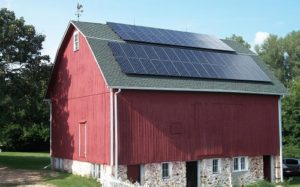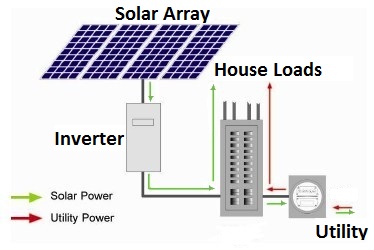Solar Electric (Photovoltaic)

12.4 kW photovoltaic roof mount
Full Spectrum Solar specializes in “grid-interactive” solar electric systems. These systems often produce more power than the site uses during the day. This excess energy is fed back into the grid through the electric meter and sold to the utility, resulting in a lower electric bill or even a monthly credit.
How it works: PV stands for photovoltaic, which describes materials that produce an electric current when exposed to sunlight. There are several types of PV technologies but the most common and efficient is the crystalline silicon cell. These cells are assembled together in an aluminum frame and covered with tempered glass. All PV solar panels generate direct current (DC), which flows through wiring to an inverter, often mounted in a garage or basement.
The inverter turns the DC energy into alternating current (AC), the type of electricity provided by the electrical grid. The AC power is routed to either the building’s main electrical panel or directly to an electric meter. In some situations, module level optimization is used to provide greater efficiency by introducing module level monitoring and per-module maximum power point tracking. This can reduce the negative effect of shading and snow cover resulting in a higher electrical output from your system.
A major advantage of solar PV is that there are no moving parts aside from the electrons, creating the most reliable and efficient renewable energy system available. Grid-tied systems send any energy that is not immediately consumed into the grid to be sold to other customers resulting in little energy waste. Another positive of solar PV is that the panels are sustainable – the silicon cells are crystallized from purified sand and can be recycled along with the aluminum and glass after a few decades of use.
PV technology continues to become cheaper and more efficient while fossil fuels generally become more difficult and costly to extract via techniques such as hydrofracking, tar sand refinement and deep-sea oil drilling. The current pricing on panels and inverters is near the lowest ever and competition among manufacturers is intense. There’s never been a better time to go solar!

Image Courtesy Sunpower Corporation
